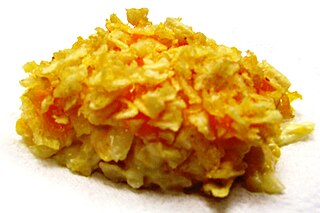
The cuisine of the American Midwest draws its culinary roots most significantly from the cuisines of Central, Northern and Eastern Europe, and Indigenous cuisine of the Americas, and is influenced by regionally and locally grown foodstuffs and cultural diversity.

Sushi is a traditional Japanese dish made with vinegared rice, typically seasoned with sugar and salt, and combined with a variety of ingredients, such as seafood, vegetables, or meat: raw seafood is the most common, although some may be cooked. While sushi comes in numerous styles and presentation, the defining component is the vinegared rice, also known as shari (しゃり), or sumeshi (酢飯).

Spam is a brand of lunch meat made by Hormel Foods Corporation, an American multinational food processing company. It was introduced in the United States in 1937 and gained popularity worldwide after its use during World War II. As of 2003, Spam was sold in 41 countries, and trademarked in more than 100, on six continents.

Shawarma is a Middle Eastern dish that originated in the Levantine region during the Ottoman Empire, consisting of meat that is cut into thin slices, stacked in an inverted cone, and roasted on a slow-turning vertical spit. Traditionally made with lamb or mutton, it may also be made with chicken, turkey meat, beef, falafel or veal. The surface of the rotisserie meat is routinely shaved off once it cooks and is ready to be served. Shawarma is a popular street food throughout the Arab world and the Greater Middle East.

The horseshoe is an open-faced sandwich originating in Springfield, Illinois, United States. It consists of thick-sliced toasted bread, a hamburger patty or other choice of meat, French fries, and cheese sauce.

Gimbap, also romanized as kimbap, is a Korean dish made from cooked rice, vegetables, fish, and meat rolled in gim—dried sheets of seaweed—and served in bite-sized slices. The origins of gimbap are debated. Some sources suggest it originates from Japanese norimaki, introduced during Japanese colonial rule, while others argue it is a modernized version of bokssam from the Joseon era. The dish is often part of a packed meal, or dosirak, to be eaten at picnics and outdoor events, and can serve as a light lunch along with danmuji and kimchi. It is a popular takeaway food in South Korea and abroad and is known as a convenient food because of its portability.

Deviled eggs, also known as stuffed eggs, curried eggs or dressed eggs, are hard-boiled eggs that have been peeled, cut in half, with the yolk scooped out and then refilled having been mixed with other ingredients such as mayonnaise, mustard and sprinkled with paprika, cinnamon or curry powder. They are generally served cold as a side dish, appetizer or a main course during gatherings or parties. The dish is popular in Europe, North America and Australia.

Fu rong dan is an omelette dish found in Chinese cuisine. The name comes from the Cantonese language.

The history of sushi began with paddy fields, where fish was fermented with vinegar, salt and rice, after which the rice was discarded. The earliest form of the dish, today referred to as narezushi, was created in Southeast Asia from where it spread to surrounding countries. Narezushi spread to Japan around the Yayoi period. In the Muromachi period (1336–1573), people began to eat the rice as well as the fish. During the Edo period (1603–1867), vinegar rather than fermented rice began to be used. The dish has become a form of food strongly associated with Japanese culture.

Takuan, or takuan-zuke, known as danmuji (단무지) in the context of Korean cuisine, is a pickled preparation of daikon radish. As a popular part of traditional Japanese cuisine, takuan is often served uncooked alongside other types of tsukemono. It is also enjoyed at the end of meals to aid digestion.

Sindhi cuisine refers to the distinct native cuisine of the Sindhi people from Sindh, Pakistan. Sindhi cuisine has been influenced by Central Asian, Iranian, Mughal food traditions. It is mostly a non-vegetarian cuisine, with even Sindhi Hindus widely accepting of meat consumption. The daily food in most Sindhi households consists of wheat-based flat-bread (Mani) or rice accompanied by two dishes, one gravy and one dry with curd, papad or pickle. Freshwater fish and a wide variety of vegetables are usually used in Sindhi cuisine. Restaurants specializing in Sindhi cuisine are rare, although it is found at truck stops in rural areas of Sindh province, and in a few restaurants in urban Sindh.

Pizza snack rolls are a frozen food product consisting of bite-sized breaded pizza pockets with an interior of tomato sauce, imitation cheese, and various pizza toppings. They are sold in a variety of flavors including cheese, pepperoni, sausage, supreme, multiple imitation cheeses, and mixed meats. Other flavors included hamburger, cheeseburger, ham and cheese, and combination. Pizza snack rolls are designed to be quickly cooked in the oven or microwave. The name "pizza rolls" is a trademark of General Mills, current owner of the original product.
The Maine Italian sandwich is a submarine sandwich in Italian-American cuisine. The Maine Italian sandwich was invented in Portland, Maine. It is similar to, but distinct from, other types of sandwiches called "Italians" and is closely associated with the Amato's sandwich shop chain, though it is found widely throughout the state. The sandwich is named for the Italian-American community in Portland and not for its ingredients. Italian sandwiches have been referred to as "a part of people's lives" in Maine.

Mett, also known as Hackepeter, is a preparation of minced raw pork seasoned with salt and black pepper that is popular in Germany. It is frequently spread on halves of a bread roll, with raw onion optionally on top. Since the 1950s mett has also been offered as a buffet dish decoratively formed into the shape of a hedgehog, with raw onion "spines". German law forbids mett being sold with a fat content exceeding 35%.

The ham sandwich is a common type of sandwich. The bread may be fresh or toasted, and it can be made with a variety of toppings including cheese and vegetables like lettuce, tomato, onion or pickle slices. Various kinds of mustard and mayonnaise are also common.

The cuisine of Minnesota is a type of Midwestern cuisine found throughout the state of Minnesota.

Pizza arrived in the United States in the early 20th century along with waves of Italian immigrants who settled primarily in the larger cities of the Northeast, such as New York, Philadelphia, Boston, and Baltimore. After American soldiers stationed in Italy returned from World War II, pizza and pizzerias rapidly grew in popularity.

Funeral potatoes is a potato-based hotdish or casserole, similar to au gratin potatoes, popular in the American Intermountain West and Midwest. It is called "funeral" potatoes because it is commonly served as a side dish during traditional after-funeral dinners, but it is also served at potlucks and other social gatherings, sometimes under different names.

Olivier salad is a traditional salad dish of Russian cuisine. Its creation is generally attributed to Lucien Olivier.

















